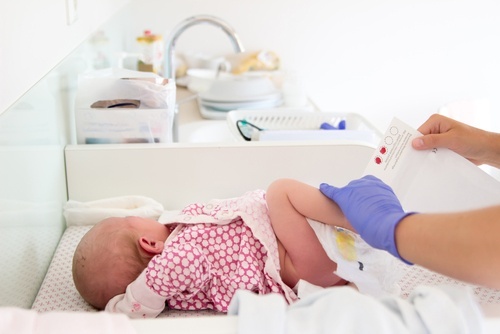Share this
microsampling and the future of newborn screening
by Neoteryx Microsampling on Jun 26, 2017 5:56:00 AM
The average weight of a newborn in the United States is about 7.5 pounds (3.5 kg). Given their limited body mass, guidelines were established to limit the volume of blood drawn for diagnostic testing.

The essential guideline for traditional blood sampling, according to Seattle Children’s Hospital, is that no more than 2.5% of the total blood volume (TBV) of an infant can be drawn at one time. In addition, no more than 5% can be taken within a 30-day period. These standards vary by country.
Infants with a bodyweight of 6.6 pounds, for example, have a total blood volume of 240 ml. Therefore, the maximum amount of blood that can be drawn for analysis may not exceed 6ml. And, no more than 12 ml should be taken in a 30-day period.
This limitation becomes a problem for conditions that might normally require continual evaluation.
Infant Blood Screening
Blood screening of newborns is conducted to detect the presence (or absence) of a number of disorders. According to the U.S. National Library of Medicine, conditions such as metabolism disorders, cystic fibrosis, HIV, sickle cell disease, and more must be determined early in order to treat properly.
Microsampling
Improved analytical processes allow for accurate diagnoses from much smaller and less intrusive sampling. Now, with the proper collection and sample-securing devices, specimens less than 50 microliters can be analyzed effectively.
A 20µl sample is smaller than 1/10,000 of the size of the 6ml sample. Most importantly, these capillary blood samples can be dried, held, transported, and stored without refrigeration or special handling and do not deteriorate the same way as whole blood samples.
Advantages include:
- Drawing a tiny blood droplet is less stressful for the infant.
- Samples may be taken as often as needed for continual observation of the progress of specific conditions and treatments.
Collection Procedure
When using Mitra® collection devices, Neoteryx notes three important outcomes. These apply to infants and adults alike:
- More frequent, less stressful sample collections can lead to better overall diagnoses and proper treatment sooner.
- Low blood volume patients, particularly infants, can be subjected to more frequent sampling at less risk than with traditional venous blood collection.
- More frequent, low volume samplings are less painful and even allow for home blood sampling of infants. In some cases, the infant may be allowed to go home sooner because the child’s ongoing condition can be analyzed remotely.
Share this
- Microsampling (206)
- Research, Remote Research (119)
- Venipuncture Alternative (105)
- Clinical Trials, Clinical Research (83)
- Mitra® Device (73)
- Therapeutic Drug Monitoring, TDM (51)
- Dried Blood Spot, DBS (39)
- Biomonitoring, Health, Wellness (30)
- Infectious Disease, Vaccines, COVID-19 (24)
- Blood Microsampling, Serology (23)
- Omics, Multi-Omics (21)
- Decentralized Clinical Trial (DCT) (20)
- Specimen Collection (18)
- Toxicology, Doping, Drug/Alcohol Monitoring, PEth (17)
- Skin Microsampling, Microbiopsy (14)
- hemaPEN® Device (13)
- Preclinical Research, Animal Studies (12)
- Pharmaceuticals, Drug Development (9)
- Harpera Device (7)
- Industry News, Microsampling News (5)
- Antibodies, MAbs (3)
- Company Press Release, Product Press Release (3)
- Environmental Toxins, Exposures (1)
- July 2025 (1)
- May 2025 (1)
- April 2025 (2)
- December 2024 (2)
- November 2024 (1)
- October 2024 (3)
- September 2024 (1)
- June 2024 (1)
- May 2024 (1)
- April 2024 (4)
- March 2024 (1)
- February 2024 (2)
- January 2024 (4)
- December 2023 (3)
- November 2023 (3)
- October 2023 (3)
- September 2023 (3)
- July 2023 (3)
- June 2023 (2)
- April 2023 (2)
- March 2023 (2)
- February 2023 (2)
- January 2023 (3)
- December 2022 (2)
- November 2022 (3)
- October 2022 (4)
- September 2022 (3)
- August 2022 (5)
- July 2022 (2)
- June 2022 (2)
- May 2022 (4)
- April 2022 (3)
- March 2022 (3)
- February 2022 (4)
- January 2022 (5)
- December 2021 (3)
- November 2021 (5)
- October 2021 (3)
- September 2021 (3)
- August 2021 (4)
- July 2021 (4)
- June 2021 (4)
- May 2021 (4)
- April 2021 (3)
- March 2021 (5)
- February 2021 (4)
- January 2021 (4)
- December 2020 (3)
- November 2020 (5)
- October 2020 (4)
- September 2020 (3)
- August 2020 (3)
- July 2020 (6)
- June 2020 (4)
- May 2020 (4)
- April 2020 (3)
- March 2020 (6)
- February 2020 (3)
- January 2020 (4)
- December 2019 (5)
- November 2019 (4)
- October 2019 (2)
- September 2019 (4)
- August 2019 (4)
- July 2019 (3)
- June 2019 (7)
- May 2019 (6)
- April 2019 (5)
- March 2019 (6)
- February 2019 (5)
- January 2019 (8)
- December 2018 (3)
- November 2018 (4)
- October 2018 (7)
- September 2018 (6)
- August 2018 (5)
- July 2018 (8)
- June 2018 (6)
- May 2018 (5)
- April 2018 (6)
- March 2018 (4)
- February 2018 (6)
- January 2018 (4)
- December 2017 (2)
- November 2017 (3)
- October 2017 (2)
- September 2017 (4)
- August 2017 (2)
- July 2017 (4)
- June 2017 (5)
- May 2017 (6)
- April 2017 (6)
- March 2017 (5)
- February 2017 (4)
- January 2017 (1)
- July 2016 (3)
- May 2016 (1)
- April 2016 (2)



Comments (1)